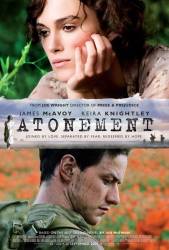Factual error: Near the beginning of the film before James McAvoy heads up to the house for the evening meal, he is seen looking up through a skylight when a Lancaster bomber slowly flies overhead. At the time it was was supposed to be 1935. The Lancaster bomber did not fly until the beginning of 1941. Can't be an Avro Manchester either, they only had two engines and first flew in 1939.
Factual error: On arriving on the beach at Dunkirk, Robbie is told of the sinking of the Lancastria and the loss of 3000 men. This event actually occurred 17 days later on June 17 1940.
Factual error: In the section of the movie set in 1935, there is a scene where Robbie is daydreaming and the image of a four engined bomber crosses the screen. The image is of a Short's Stirling (the tail configuration is markedly different to the Lancaster), an aircraft which did not enter service until 1939.
Factual error: The early scenes in Atonement take place, according to the opening caption, in "England 1935" on a single summer's day. The action shifts at the beginning of scene 9 to "Northern France four years later" according to the caption. This, then would have been the summer of 1939 when Britain wasn't yet at war. The Dunkirk retreat took place in the summer of 1940, five years after the action in scenes 1-8.
Factual error: None of the London buses used in the film was built until after World War 2.






Chosen answer: Not as such. The only systematic massacre of civilians in the Dunkirk campaign was in the Flemish village of Vingkt, where the German 377th Infantry Regiment had fought a fierce battle against the Belgian Chasseurs Ardennais. On 27/28 May 1940, the Germans took revenge on the civilian population and shot some 40 men and boys in the village, including eight elderly men who had sheltered in a convent's cellars. They argued that anyone found in a building the Chasseurs had used was liable for execution. The film exaggerates for dramatic effect - dead schoolboys are more poignant than dead old men - but there is a core of truth in the story.